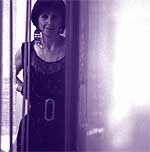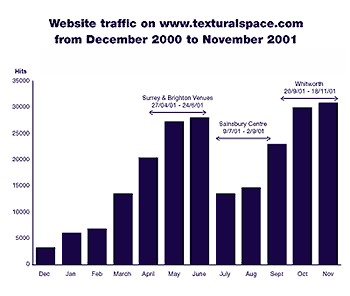contemporary Japanese textile art
an
exhibition curated by Lesley Millar
originated through
The Surrey Institute of Art & Design University College
Review
December 2001
The touring exhibition TEXTURAL SPACE: contemporary Japanese textile art, has been an extremely successful project. It has achieved all its target objectives and has received a huge, appreciative response from the public with 83,415 visitors during its eight-month tour of the UK. The exhibition opened in April as one of the first events of ĎJapan 2001í, divided between four venues in the South East of England: The James Hockey Gallery Farnham, Brighton Museum and Art Gallery, Maidstone Library Gallery and Rochester Art Gallery. At this time, in a de-consecrated church in Brighton, Machiko Aganoís breathtaking 15m x 10m x 4m hand knitted installation, made from fishing wire, stainless steel wire and hand made paper, attracted an overwhelming, record, 25,000 visitors. Kyoko Kumai has generously donated her work, shown at Rochester Guildhall, to the Medway Council permanent collection and it will be on long-term display from later in 2002.
In July and August, at the Sainsbury Centre For Visual Arts, the extraordinary synthesis between art and architecture at this venue attracted visitors from throughout the UK., Europe, Australia, North America and Japan. In Manchester, to coincide with the showing at The Whitworth Art Gallery, TEXTURAL SPACE entered into partnership with Arts and Business and MUJI. Kyoko Kumai created a stunning installation of her stainless steel fabrics within the MUJI store in the city centre.
The education programme has been fully subscribed throughout the tour, and the Teachers Pack was reprinted three times. At The Whitworth Art Gallery every slot for every day from September to November was taken. Practitioners, critics, teachers and students from all over the UK., Europe and Japan attended two major conferences, at The Surrey Institute of Art and Design and The Sainsbury Centre for Visual Arts.
The beautifully designed catalogue, has been purchased equally by the general public and those who have research requirements. The TEXTURAL SPACE website www.texturalspace.com has proved extremely popular and a useful means of disseminating information. TEXTURAL SPACE has received positive coverage in 42 magazines, 13 national and 43 regional newspapers. As originating organisation, The Surrey Institute of Art and Design, is delighted with the high profile the exhibition has received from the press and the public.
Now that TEXTURAL SPACE has completed its tour, a new cycle is beginning, funded through the Daiwa Anglo-Japanese Foundation and The Arts and Humanities Research Board. This project will bring Japanese and UK textile practitioners together in one project under a mentoring scheme allowing emerging artists in one country to work with established artists in the other and this will culminate in the setting up of an Anglo-Japanese Textile Research Centre at The Surrey Institute of Art and Design.
 |
Venue:Brighton
Museum and Art Gallery Subject:Lesley Millar Photographer:Iraida Icaza |
Lesley
Millar
Curator
TEXTURAL SPACE
Daiwa/AHRB Research Fellow, Surrey Institute of Art and Design, University
College
At the Sainsbury Centre for Visual Arts, Chika Ohgi took up a 14 day residency. The Centre provided a studio space and during this time she created a response to the building and the permanent collection. To do this she used silk threads from an obi which she dipped, at intervals, in paper pulp. She ran two workshops in which participants contributed to the work. The threads were then weighted and hung across the mezzanine floor. The resulting installation was one of beautiful understatement, responding to and echoing the Foster building. The perfectly weighted threads turned slightly in the wind and as they did the paper fragments caught the light and then disappeared.
At The Whitworth Art Gallery in Manchester, Koji Takaki took up an 18 day residency based within the Galleryís public space. He created a response to the building which was sited in the grounds at the front of Gallery. He worked every day in the Gallery and responded to the public. Manchester Metropolitan University provided facilities for him and student assistance. The work, hung outside on two scaffolding constructions, provided a framework for the building, the material, cotton providing a link with Manchesterís textile history.

Funded
by
The Surrey Institute of Art & Design, University College
The Regional Arts Lottery Programme
The Arts Council of England
The Crafts Council of England
South East Arts
Brighton Festival
Visiting Arts
Kent County Council Arts & Libraries
Medway Council
The Worshipful Company of Weavers
Arts and Business New Partners
Muji
North West Arts
Japan 2001
The Daiwa Anglo-Japanese Foundation
The Great Britain Sasakawa Foundation
The Japan Foundation
Pola Art Foundation
Supported
by
Conqueror ģ
All Nippon Airways
Yamato Transport
Production
UK - The Surrey Institute of Art and Design
Japan - Keiko Kawashima, Director Gallery Gallery, Kyoto
Photography: Stamina Kawabe Photo Studio
Design: Direct Design, London
Website: site-designs.co.uk
Print: Albany House
PR: Cawdell Douglas
Market Research: Angela Hilton
Teachers Pack: Bob White
Venues
The James Hockey & Foyer Galleries
Brighton Museum and Art Gallery
Fabrica
Maidstone Library Gallery
Rochester Art Gallery
Guildhall Museum
Sainsbury Centre for Visual Arts
The Whitworth Gallery
|
...Texture is becoming an increasingly important issue in building design; and touch-feelies who crave a glimpse of this tactile future recently beheld an accident of revelatory perfection in Norwich. There, in Norman Foster's 1978 Sainsbury Centre for Visual Art, an array of materials - crinkled, delicately webbed, shimmering, rumpled, translucent - contributes to a chance essay on the relationship between architecture and the Japanese fibre artworks in the TEXTURAL SPACE exhibition...a brilliant coup: textiles as phantom architecture in one of Britain's most rigorously achieved architectural spaces...'
Jay Merrick |
|
I found it fascinating - the use of unconventional materials in Textile work and the imaginative use of conventional materials. It was extremely inspirational, I just want to start designing and making my own Textural sculptures. Also the scale of the pieces is incredible. The most enjoyable gallery visit I have made for a long time.
Textile teacher/lecturer |
|
'There is a huge variety of work and, in spite of the labour intensiveness, the artists have maintained a lightness and freshness which appears effortless, like breathing...visitors respond as if in a sacred space. It is for most a spiritual experience...For those unable to visit this extraordinary and beautiful exhibition there is a superb catalogue which reflects the exhibition's design and sensibilities...' Frances
Geesin |
|
total visitors
to |
|
Successfully raises awareness of a specific and underrated area of art and design, which all the best exhibitions do (by definition!) Standard of work is simply the highest. Draws together common themes and aesthetics to suggest a movement in an uncontrived way. Student
|
|
'TEXTURAL SPACE...one of the most interesting events of this yearís Japan 2001 cultural programme...of particular interest to architects because it is the 3D qualities of the Japanese tradition of fibreworks or textile art that set it so firmly apart from a Western concept of the role of textiles in buildings...The show challenges us to think again, not just about textiles and how we use them, but how we define and experience space.' Catherine
Croft |
|
'The installation was visually stunning, the subtle lighting an integral element of the work... their work though non-functional in the strictest sense, and unequivocally on display in a gallery as art, celebrates Mingei ideals of purity, honesty, simplicity and craftsmanship...The monumental scale of (Chika Ohgi's Water Pillars) was tempered by the intricacy of its construction - the tension between the micro and macro awe-inspiring...' Kate
McIntyre |
|
Takakiís textile Spaces...create strange in-between worlds of subdued light and mysterious shadow, where one layer reveals a sight of another layer, neither interior nor exterior...The Japanese do not differentiate between art and design, between built structure and decoration.
Matthias Thibaut |
Download a printable Adobe Acrobat version of the Closure Review Document
Note: due to the quantity of images we have produced two different quality files, please select the most appropriate for your connection speed. Clicking on the link will open the document in your browser, to download to disk just 'right click' and select 'save target as' (option click if you're a Mac user)
ClosureReview_small.pdf (1.21Mb)
or
ClosureReview_large.pdf (8Mb)
|
Amazing! Very influential. I canít believe it was all knitted by one person. It is the best piece of art Iíve ever seen. Iím only 12 and I feel so strongly about the art of this art! Member of general public, Fabrica Installation Brighton 19/6/01 |
|
|
'To arrive in Brighton on a beautiful spring day, a cleansing chill adding an edge to the sea breeze, proved the perfect prelude to the work of leading Japanese textile artists, similarly beautiful and cleansing. ...in the hands of the Japanese, 'textiles' achieve astonishing and harmonising subtleties worthy of nature itself as in Shihoko Fukumoto's linen hangings dyed in infinitely differentiated shades of indigo 'Opening Moon' and 'Closing Moon'...One evening last week I looked at the evening sky and with a shock of recognition saw Fukumoto's moon -the harmonising connection of inner and outer, mind and eye suddenly reconfirmed. Now that is art.' John
McEwen |
|
|
TEXTURAL SPACE lived up to its name. The space was an important part of the whole concept. I liked the airiness which implies space, and I found the journey interesting, travelling as it were in this space through white and reflected light to dark, rich colours and exciting textures. Artist, Sainsbury Centre for Visual Arts Norwich 28/8/01 |